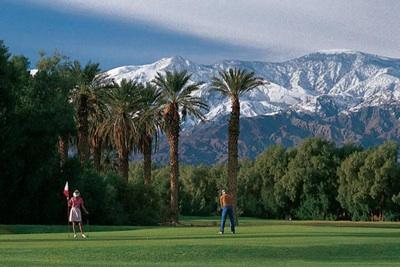Like it hot? Then plan on visiting Death Valley National Park this summer. But don't forget your swimsuit, as you'll most definitely want to cool off in the pool, even if it is warm water.
Judging by the number of people hanging out at the Ranch at Furnace Creek at lunchtime in July, then some folks truly do like it hot. Lots of people, in fact. This arid, desolate and ruggedly beautiful park typically draws some 230,000 travelers during the summer months, when the temperatures can be as high as 125 degrees Fahrenheit.
Situated in east-central California on the edge of the Mojave Desert, the park hosts as many as 900 tour bus travelers each day. Nearly all of the visitors are from European countries; most come from Germany, France and the UK. Lunchtime in the Wrangler Buffet is a smorgasbord of languages – German, French, Italian and Dutch.
“Although we have domestic travelers too, Europeans in particular love Death Valley during our extreme summer months,” said Phil Dickinson, director of sales and marketing for Furnace Creek Resort. “The American West, with its wide open spaces and distinctive landscapes, is a beloved travel destination for European travelers, and Death Valley is particularly appealing to this group, in part because of the extremes.”
Death Valley is one of the hottest places on the planet, with a record-high temperature of 134 degrees Fahrenheit recorded in 1913.
Yet heat is not the only extreme in this 3.3 million-acre park. With a low point of 282 feet below sea level at Badwater Basin, it is also one of the lowest places on Earth. For perspective, Badwater visitors can look up on a cliff – way up – and see a sign marking sea level. And from that point, travelers can look across the valley to Telescope Peak in the Panamint Mountains, which rises to 11,049 feet above sea level.
Death Valley is also dry, receiving less than 2 inches of rainfall per year on average. In years the park receives more than that amount, there are often flash floods in low-lying areas due to the lack of vegetation and the broad expanses of impermeable rock.
In addition to the tour buses, the Ranch hosts golf groups with a penchant for the extreme and automotive companies conducting hot-weather testing for new vehicle models. Golfers play the year-round Furnace Creek Golf Course all summer. And more than 50 intrepid golfers are expected to participate in the second-annual Heatstroke Open June 22-24.
In mid-July, 90 of the best runners on Earth will compete in the “Badwater Ultramarathon,” a 135-mile race that begins at Badwater and ends at Mount Whitney. In between, runners pass through three mountain ranges. The invitation-only race is described by its organizers as the “most demanding and extreme race on the planet.”
Plus, there are Hollywood movie shoots and national magazine photo shoots regularly staged throughout the park. The park’s otherworldly landscape makes it a particularly great location for science fiction movies. Parts of the 1977 mega-hit “Star Wars” were filmed in the park.
Xanterra Parks & Resorts, operator of the Ranch at Furnace Creek and concessions in the park, continually educates visitors about the potential dangers of the park’s extremes through signs and park guides.
“We advise our summertime visitors to drink plenty of water, wear sunscreen and hats and to limit physical activities to the cooler early-morning and evening hours,” said Mr. Dickinson. “The Badwater runners never listen to us on that latter point though.”
To harness the power of the unrelenting sun, Xanterra constructed a five-acre, one megawatt solar PV system four years ago. The massive system powers more than one-third of the resort’s electricity needs annually.
Xanterra’s year-round operations include the 224-room Ranch at Furnace Creek; 18-hole Furnace Creek Golf Course, the world’s lowest course at 214 feet below sea level; two restaurants; a saloon; general store; spring-fed swimming pool; tennis courts; the Borax Museum and a service station.
In addition, there is a 3,000-foot airstrip adjacent to the property. Xanterra also operates the AAA Four-Diamond-rated Inn at Furnace Creek, open mid-October through mid-May.
The Inn includes a restaurant, gift shop, spring-fed swimming pool, tennis courts, lush gardens and conference and banquet facilities. The Inn provides a stunning and lush oasis in a harsh climate thanks to water flowing from nearby natural springs.
For more information about facilities in Death Valley National Park or to make reservations at in-park lodges, call toll free at 1-800-236-7916 or 1-303-297-2757 or go to www.furnacecreekresort.com .




Comments
Traveled to Death Valley a few years ago in October with my daughter and the day-time temp was still in the triple figures. It made for long days with my 12 year old daughter but astounding views both day and night. Thought we'd "cool" off in the pool at night but water temp was 86 degrees on the pool thermometer. Not cool or comfortable - just wet.